Fallschirmjager – Crete 1941 (2011 project)
Project update May 2012 – Added some heavy weathering with mud and sand coloured pastels to this project done some 15 months ago (Feb 2011).
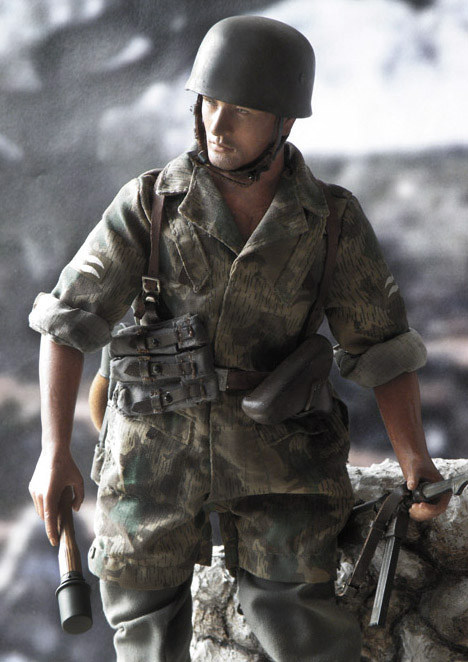
This is one of Dragon’s early FJ release; the Fallschirmjager jump smock is the Type II, step-in version. Several variations of the Type II were made, and this is the later 1940 “factory” variation which saw widespread use on Crete. Considered the most common model smock worn during the early and mid-War period, these smocks were still common and widely issued in 1944. Type II smocks were originally made in green, with Splinter B pattern fabric being phased in during production in 1940.
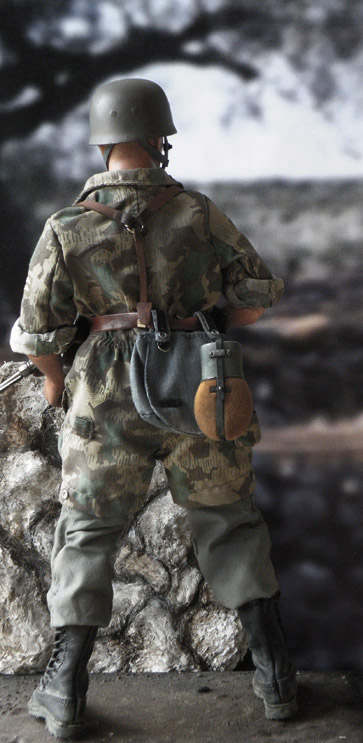
Back view showing the barest amount of gear worn by the parachutists. The Luftwaffe Y-straps was scratchbuilt out of leather with the rough side out, with DML original metal fittings.
The Fallschirmjager, the German paratroopers of World War 2, made the first airborne infantry assaults in history. When Germany invaded Western Europe in 1940, the German paratroopers parachuted and landed with gliders and captured strategic positions. A year later, in May 1941, in their greatest operation, they invaded and conquered the big island Crete in the Mediterranean solely by airborne troops. Their losses were such that Hitler decided never to do another large airborne operation, so the German paratroopers served the rest of the war as elite infantry.
The military use of paratroopers as airborne infantry is originally a Russian innovation. Since the 1920s the Russian military exercised and demonstrated the use of paratroopers in increasingly larger scale. Some foreign officers were allowed to observe these exercises. One of them was a German Colonel, Kurt Student, who was a fighter pilot and squadron leader in World War 1.
Student was excited by the military potential of paratroopers, but the establishment of the German paratroopers force was delayed until the German military buildup began in 1935. In the meantime Student became an expert with gliders, the other element of his future airborne force (after World War 2 the helicopter replaced the glider as the vehicle of airborne landings).
The German paratroopers force, the Fallschirmjager, was established in January 1936, with the enthusiast Student as its commander. It began as a single battalion of paratroopers and kept growing rapidly, becoming a division in 1938 and later a Corps, including paratroopers, glider troops, and elite infantry. It was a large and independent elite force of selected and very highly trained volunteers. They developed new tactics and techniques which improved their performance, such as the parachute-opening cord tied to the aircraft, which made parachuting safer and enabled them to jump from lower altitude and reduce exposure to enemy fire. The Fallschirmjager force belonged to the German Air Force. The concept was that they will be used to achieve what air bombardment can not, mainly capturing strategic positions behind enemy lines instead of destroying them.
Their transport aircraft were the common Junkers 52, which carried 17 paratroopers, and the DFS 230 glider, which carried over a ton of heavier weapons and equipment, or troops, and could be towed by an empty Junkers 52 and released over the landing zone.
Since 1938 the Fallschirmjager prepared for planned operations in Czechoslovakia, Austria, and Poland, but these were cancelled. Their first assault was in April 1940 in Norway and Denmark, when airborne forces landed in key Norwegian and Danish airfields and captured them to allow safe landing of additional forces. The Junkers 52 was used as a passenger aircraft before the war and many of the German pilots landed in those Norwegian airfields before the war, so the surprise and deception were perfect, and once they landed the Germans quickly overwhelmed the defenders.
Their second operation, which this time included parachuting and glider landings, was a month later in the invasion of Western Europe. They did what paratroopers do best, and captured vital river bridges behind enemy lines which the advancing German armor needed to cross, and a formidable Belgian fortress, Eben Emael, which guarded other key bridges.
Eben Emael was manned by about a thousand Belgian soldiers and was strongly fortified. It was a set of seven large fortified artillery positions, with 18 artillery guns, surrounded by many machine gun positions, mine fields, barbed wire, a moat, and connected via underground bunkers and tunnels.
On May 10, 1940, at dawn, this fortress was attacked by just 78 Fallschirmjager troops which landed on top of it with 10 gliders. They were equipped with light weapons and with several 100 pound armor piercing explosive charges. Before the raid these 78 paratroopers trained on a full size model of the Eben Emael fortress. They landed precisely on the roof of the large fortress in total surprise, and with their far superior fighting skill over the shocked Belgians they were able to quickly take over the roof area and confine the defenders to their fortified bunkers which they cracked one after the other with their special explosive charges. The German losses were just six dead and twenty wounded. A day later, when the paratroopers were joined by German ground forces, the hundreds of remaining Belgian defenders inside the fortress surrendered.
The small elite force of just 78 German paratroopers defeated a greatly larger force in a mighty fortress. It was a great success which remains one of the most daring and successful raids in history, a model of what elite soldiers can achieve in properly planned raids.
Kurt Student himself suffered a severe head injury in the fighting in Holland, but survived. A year later he was back on duty and he and Erwin Rommel proposed a large scale airborne operation.
Operation Mercury – the airborne invasion of Crete
They proposed that an entire Fallschirmjager division will parachute and land with gliders in the large island Crete in the eastern Mediterranean, overcome its allied defenders and occupy it, with the support of reinforcements which would follow by air and by sea. Italian-occupied Greece was a gateway to the Balkans and the Cretan harbour of Suda Bay was the best in the eastern Mediterranean. Outgunned and outnumbered in the rush of the withdrawal from Greece, the British had abandoned most of the essential and heavy equipment. Soldiers had their personal weapons, but ammunition and stores were in short supply; there were barely the tools for preparing the much-needed defensive positions. Big weapons – tanks and guns – were few and far between. Airfields at Maleme and Retimo, and the aerodrome at Heraklion, had no aircraft, for the British needed resources elsewhere in the region.
In these circumstances, the job of defending Crete would be tough. Even the few strengths were potential weaknesses. The port and the airfields would become dangerous if they fell into German hands. Both were vital to the Allies’ supply of equipment and air support so they could not be destroyed.
There was some discussion among the German high command about whether to invade Crete or focus efforts on the Soviet Union; but impressed with the former successes of the Fallschirmjager, Hitler agreed, on condition that the operation in Crete will end before the beginning of the invasion to Russia a month later, but this was much more time than Student needed.
The strategic German goal in taking Crete was to make it a forward German base, mainly for the Luftwaffe, allowing it to more easily locate and attack British warships and convoys in the eastern Mediterranean and by that help Rommel in his North African campaign against the British forces in Egypt.
Crete was held by about 35,000 lightly armed New Zealanders, British, Australian and Greek troops, most of them recently evacuated to Crete from mainland Greece and assisted by Cretan civilians. Thanks to intelligence – by deciphering encoded German messages, British intelligence had learned of German plans for an invasion of Crete – the attack itself was not a surprise. It was also clear that the attack will be at the long North coast of Crete. The allied forces prepeared for the attack with what they had, and the Royal Navy patrolled in the sea North of Crete.
The Germans gathered near Athens forces and equipment for the operation from all over Europe. Student had:
- 3 elite infantry divisions (paratroopers division, airborne division, mountain infantry division)
- 500 Junkers 52 planes and 72 gliders for air transport
- 300 fighters, 200 Stuka dive bombers, and 30 other bombers for air support
- Civilian ships for troop transport and a force of torpedo boats for escort
The only flaw in the German preparations was that their intelligence underestimated the British force in Crete at a third of its actual size. This cost them very heavy casualties during the attack.
In the morning of May 20, 1941, Crete was again heavily bombarded by the Germans, but this time the bombers were followed by large and dense formations of Junkers 52s carrying paratroopers or towing gliders. They attacked in several places but the main attack was in Canea and in nearby Maleme in the West side of Crete’s North coast. There was an airport and a harbor there and both were defended.
The Allies on Crete had expected the attack for several days in mid May, but the sight of the enormous airborne invasion stopped them in their tracks. Hundreds of planes lumbered through the sky, disgorging German paratroopers into the area around Maleme and the township of Chania from dawn on May 20. Later in the day, paratroopers dropped into the area around the airfields at Retimo and Heraklion.
“They were coming over with big Dorniers, planes with gliders on behind. They let the gliders go. A lot of [paratroopers] came down in the olive groves and were killed. They were in front of us, behind us, beside us. We didn’t know where they were…. [We were] busy trying to stay alive, because you didn’t know where the Germans were… A lot of them were hung up on trees – killed coming down.”
Cyril Crosland, a New Zealand’s Army Service Corps driver in Crete, was finishing breakfast on 20 May 1941 when he looked up into the sky.
Many German paratroopers died before they could reach the ground; others, their equipment tangled in trees, were mown down as they struggled to release themselves. In one German battalion alone, about two-thirds of the men along with its officers were dead before the day was over.
‘After the initial shock we realised the paratroopers were restricted, being strapped into the parachutes, and became sitting ducks. Those who dropped on top of us just did not survive. The equipment, which came down in separate parachutes helped us tremendously, as we were very short of supplies and equipment.’ Tom Foley
Cretan resistance
Cretans too became involved in the battle. On the first day there was determined resistance to the Germans around Alikianou-women and children were also involved, armed mainly with shotguns. Some Germans were killed with axes and spades.
‘A bit later on, it was a few days after the parachutists arrived, we used to see these old Cretans—most of the young fellas had gone, you see—these old fellas come along and pass through… ‘Which way are the Germans?’ And they’d be out for a day’s shooting. Blunderbusses…Carbines, I suppose they could have been. And they’d go back home again at night…’
Ted Martin-Smith—transcript of interview with Megan Hutching, 22 November 2000
By the end of the first day, the Germans had a foothold near Maleme. Many paratroopers had landed in the undefended area west of the Tavronitis River and around Chania. The 6000 German paratroopers which landed in Canea and nearby Maleme , and also those which landed in the East side of Crete, fought all day, with heavy casualties, but allied defenders held their positions and it seemed that the Germans were going to lose the battle. The Germans had gained less than they expected, and morale at German headquarters in Athens was low. Furthermore, at night the Germans seaborne reinforcements were intercepted and sunk by the British Navy. The German paratroopers also lost direct radio contact with the operation’s command post in Athens which had to rely on pilots’ reports to evaluate the situation.
It was clear to Student that he must urgently reinforce his paratroopers on the ground or lose them, but he didn’t know if it was possible to land more troops in the airport at Maleme. He ordered Colonel Ramcke who commanded the paratroopers in West Crete and later became one of the most highly decorated German war heroes, to take Maleme at all cost, and then sent a single Junkers 52 to try to land in Maleme and return to report.
The German pilot landed in Maleme at dawn, under fire, stopped the Junkers 52 near some surprised German officers, received an updated situation report from them, and took off again. Once safely airborne again, the pilot immediately reported to Student that landing is possible, and Student immediately ordered the reinforcement force, which were already waiting inside their airplanes, to take off and fly to Maleme.
In the fierce battle of Maleme, the allied side made one critical mistake which greatly helped the Germans at the most critical time. The commander of the allied force which held the hill that covered the Maleme airport with fire, was under continuous pressure by Ramcke’s paratroopers. The allied commander and his superiors failed to understand the key importance of preventing the Germans from using the airfield to bring in their reinforcements, so instead of receiving available reinforcements and hold this hill, the allied commander was permitted to abandon it, and it was just before the German Junkers planes began landing in Maleme with reinforcements.
It was a classic example of the importance of holding the higher ground position, which in modern fighting often translates to achieving air superiority, and there, in Maleme, abandoning the higher ground cost The Allies the battle, the island of Crete, and heavy losses which they suffered in the rest of the battle.
With the arrival of more and more reinforcements landing in Maleme airport, the Germans could finally secure their beachhead in West Crete, receive some reinforcements by sea (their total force in Crete reached 17,500), and start pushing the allied defenders. After several more days, the allied commander in Crete realized he was fighting a lost battle and ordered to evacuate his forces from the island, an evacuation which suffered heavy losses in men and ships to German air attacks.
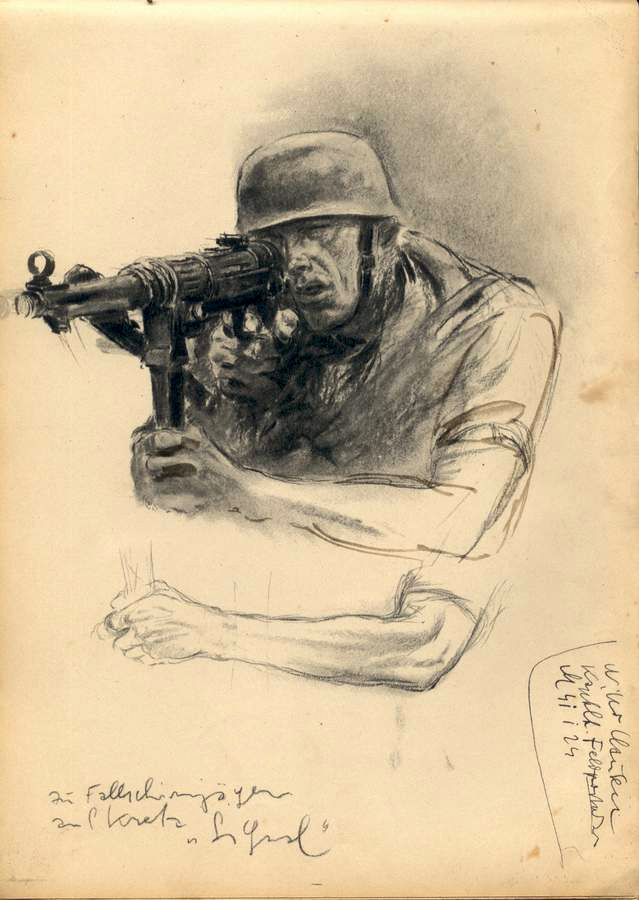
Hans Liska (1907-1984) is one of the most well-known and prolific WWII Axis illustrators, who served with the German Armed Forces during the war. In 1942 and 1943 German publishing house Carl Werner in Reichenbach, sponsored by Junkers Flugzeug und Motorenwerke AG, published 2 albums with Hans Liska’s sketches and color illustrations “to please the frontline soldiers and the workers of the weapon factories” in Germany. Definitely, Liska’s art lived up to the expectations of his peers, and propaganda clichés left the well-recognizable footprints all over his painting and drawings. However, at the same time artist was also able to create something more valuable than NSDAP-commissioned propaganda poster for the crumbling wall of the neighborhood bakery in bombed-up German provincial town. Liska convincingly demonstrates that he has an eye for the real war drama, with all its pain, suffering, desperation, hard work, endurance, sense of duty, and courage for yet one more push to the utmost, which all participants are likely to share, no matter under what colors they fought and died.
Paratroopers on the ground
The German paratroopers conquered Crete, but at a heavy cost of thousands dead and thousands wounded, mostly of Germany’s finest soldiers, and the loss of 170 transport aircraft and dozens of fighters and bombers. These losses were dwarfed just months later by the tremendous German losses in the fighting in Russia which began a month later, but in mid 1941, at the peak of his triumph, Adolf Hitler was shocked by the heavy losses of the paratroopers’ invasion of Crete and he decided that there will be no more large scale German airborne operations. In the rest of World War 2, other than a few insignificant small operations, the Fallschirmjager fought on the ground, as elite infantry. They proved themselves again and again as formidable opponents, especially in Monte Cassino (early 1944), in Normandy, and in Holland, where they defeated the British paratroopers in Arnhem. The lessons of large scale operation of paratroopers by the Germans were learned by The Allies, which later during the war made several such operations.
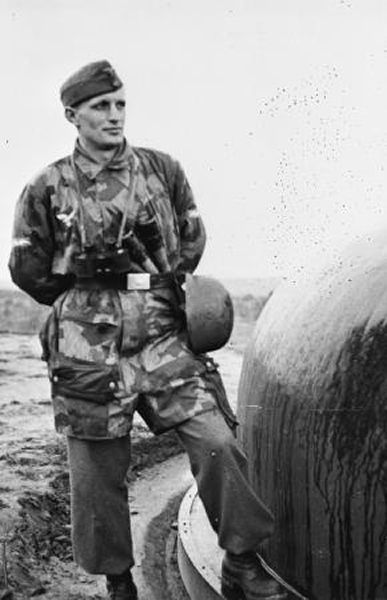
German paratrooper on Crete. The photograph shows a knee length smock, in this instance camouflaged. Points of note are the numerous pockets in the lower part of the smock, the long trousers tucked into the boots, the two stick grenades pushed into the belt and the steel crash helmet carried at the side. This man is wearing on his right breast the Eagle and Swastika sign of the German Air Force (German paratroopers are air force not army troops). In pockets of the smock are usually carried the following: message pad, talc map case, compass, packets of automatic tracer and AP ammunition. source:nzhistory.net.nz
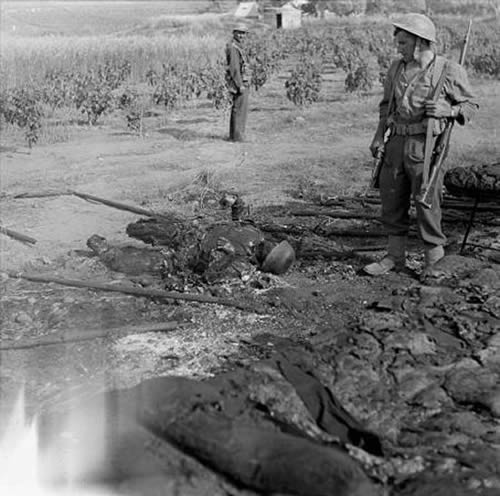
The remains of a German paratrooper who was killed in a burning tent at 7 General Hospital. Source: nzhistory.net.nz
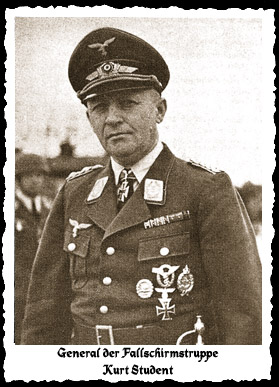
The name of Crete is for me- the man who conquered it- a bitter memory. I made a wrong decision when I suggested this attack, since not only did it mean the loss of so many paras who were my sons, but also the end of the Fallschirmjäger, which I created myself.” General Student – after the war..
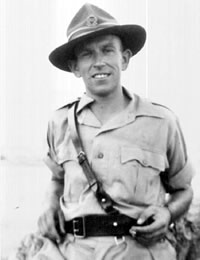
2nd Lieutenant Peter Wildey of 7 Field Company describes shooting at German gliders and killing and taking equipment from paratroopers. He also describes several other incidents during the retreat to Sfakia.
Part One: Firing at German gliders and paratroops in the sky
Transcript
Megan Hutching : Tell me about the 20th of May.
Peter Wildey: Well, we were having breakfast. We’d just finished it, I think, when all of a sudden two gliders came in. I knew what a glider was. We’d had a gliding club in Dunedin. But everyone was looking at them; they didn’t have a clue what they were. So I opened up my tommy gun. They were at a very low altitude. They were lucky to get through without hitting the Cemetery Hill area. I had a hundred-round magazine on [the tommygun], and I managed to pour the whole lot into those two. I couldn’t help hitting some, just raking it from stem to stern. Eventually those gliders landed down by Divisional Headquarters [near Galaria] where Major Hanson was, and of the [Germans] that did come out, they killed the lot. That famous painting of Peter McIntyre’s was one of those gliders.
After I got going, the others started joining in. Shortly after that, just right on their heels, these big transports came in, great big tri-motor things. The chaps just started pouring out of them. We fired at them as they were coming down, as hard as we could. The 19th Battalion was above us and that was the trouble. The Germans arrived amongst us, and they [19th] were firing down at the parachutists, but they were firing amongst us too, and the poor old Greeks—I think they killed a lot of Greeks because the Greeks had little wee helmets that looked something like a German helmet.
Part Two: Successful initial attacks
Transcript
That first thing would be about an hour, I suppose. We were shooting, and ducking and diving. One big German was coming down right on top of me. I was getting bursts of the tommy gun into him and he took out a hand grenade, and I could see it coming right for me. I flattened out but it landed just the other side of a line of vines—it was in a little vineyard—and I didn’t get a scratch. But I didn’t get another squeak out of him. I think I must have killed him. Others were coming down and they were swinging in the air, from side to side like a pendulum. I think that was a ruse to make it hard to shoot them. I cottoned on, and I waited until the end of the swing and kept my tommy gun pointing there till they came back the next time and I managed to shoot at two or three. Whether I killed them or wounded them, I don’t know.
It was too hot where we were with the 19th Battalion firing on top of us too, so I manoeuvred around to a place where I got into the 19th Battalion. I saw the OC of the 19th and they gave us a position in their line where we had better height and we could see around. We were just opposite Galatas. I had about 30 or 40, could have been 50, Greeks that came along with us, and they [19th] got rations for us.
We did a lot of damage, and with the 19th Battalion forced them [Germans] over the hill, and they got eventually forced down into the Aghya Valley. They were there till the end of the week, then they finally counter-attacked and came back again.
Part Three: ‘Acquiring’ things from dead German paratroopers
Transcript
Megan Hutching: Did you manage to acquire things from the dead German paratroopers, like weapons?
Peter Wildey: Oh yes, a lot of [the troops] got Luger pistols. The [Germans] all had beautiful cameras, Zeiss cameras. Lots of them had photos in—they got the films developed later. All their gear was good. Their equivalent of the tommy gun was quite a tinny looking thing, it looked as though it had been made out of pressed metal, but it was very effective—and you could get all you wanted of those. Our troops used them, and threw them away when they ran out of ammunition for them.
When the parachutists came down, there was [also] ammunition and arms, food, everything—they were in big, round cylinders. They dropped those, and quite often there’d be a rush to get them—it’d be a race between our fellows and the Germans. [The British] captured documents which came with the troops and found that there was a flag code. You put strips of coloured material on the ground in a certain configuration, and you’d get a certain type of ammunition, or a canister of food, and things like that. Well, our chaps used this successfully for a while, but the Germans soon cottoned on, and they abandoned that [system]. Someone told me that they put one out and they got a canister of hot coffee and sandwiches!
Interviewed by Megan Hutching, 9 November 2000
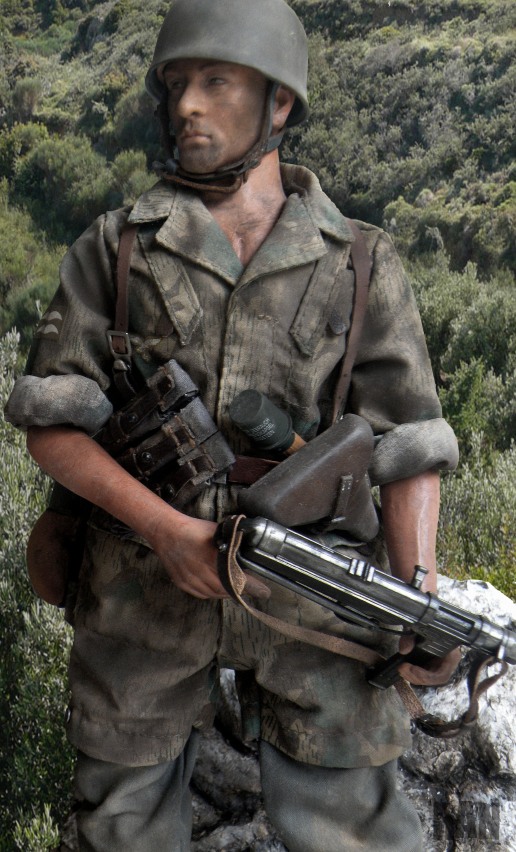
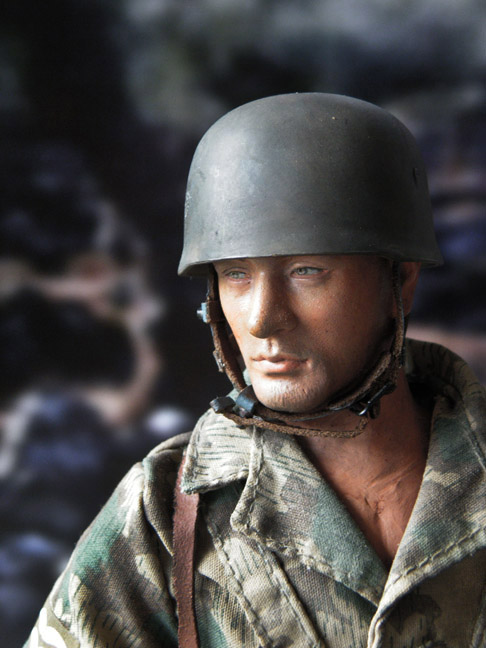
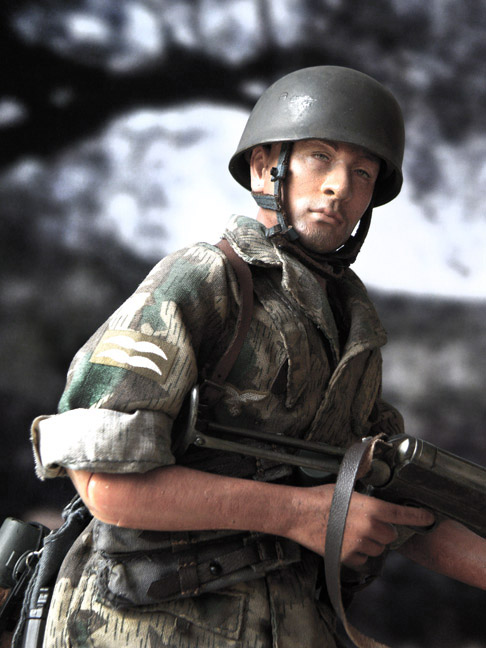
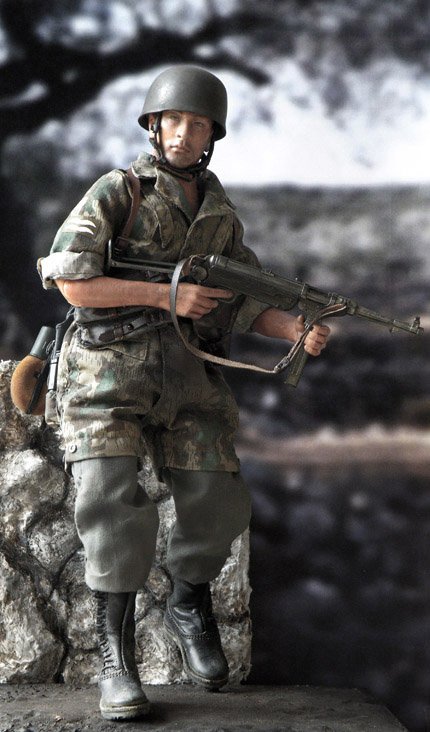
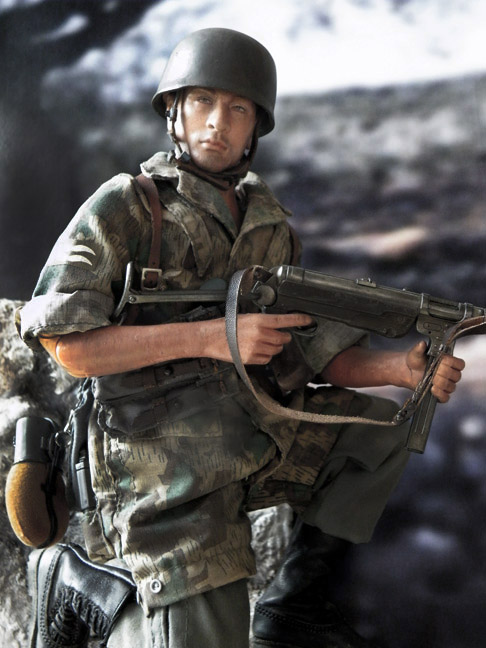
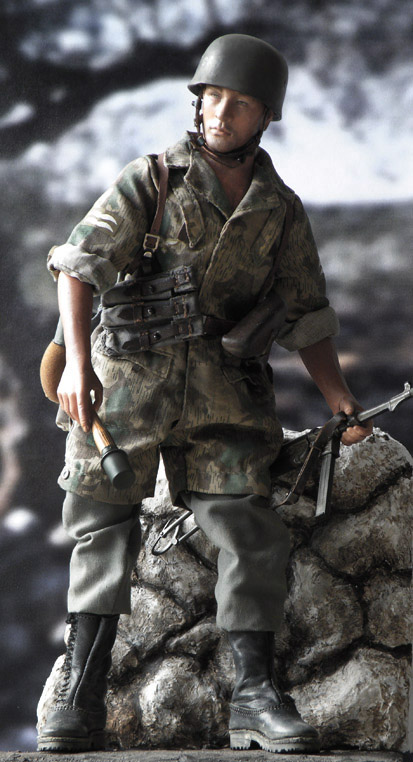
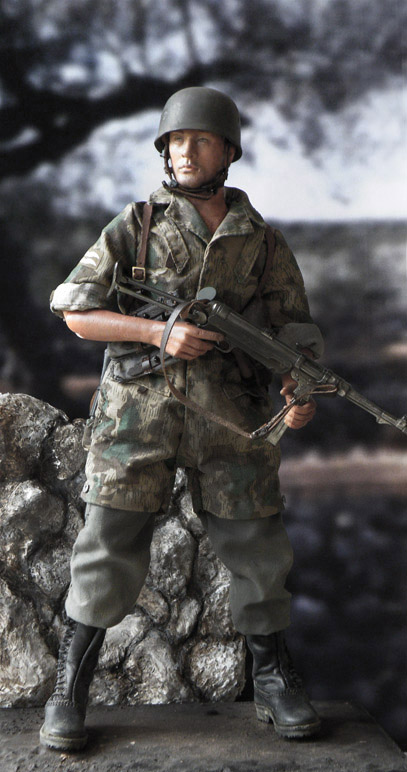
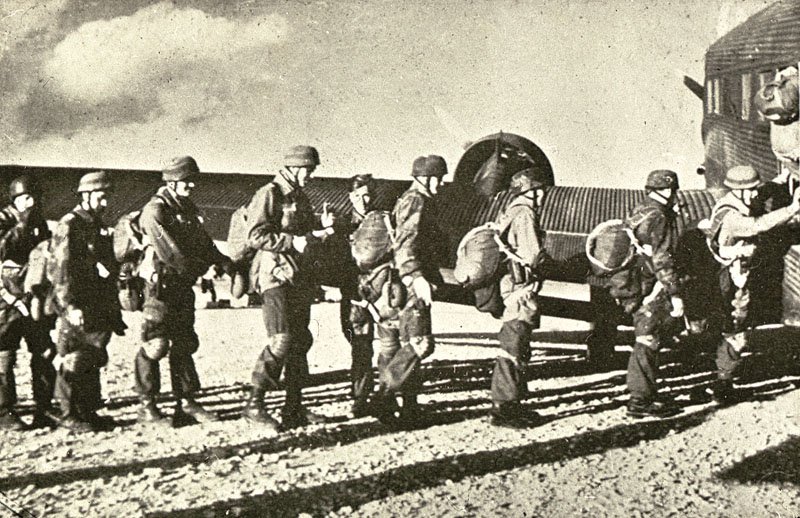
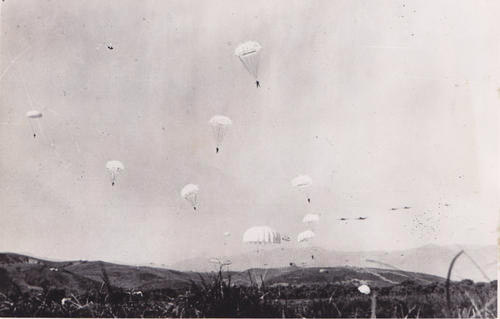
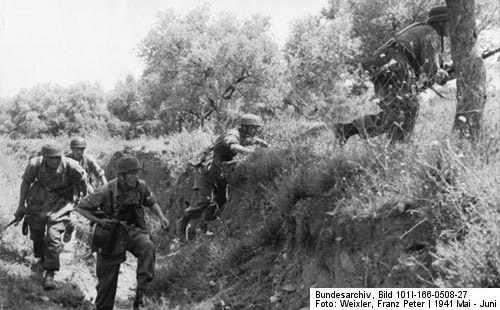

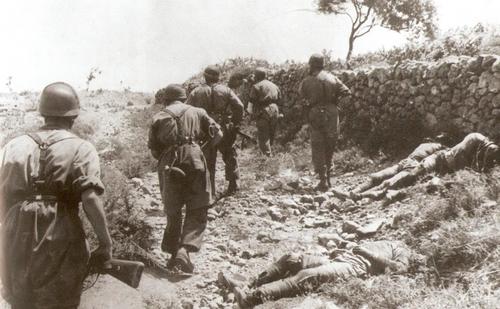
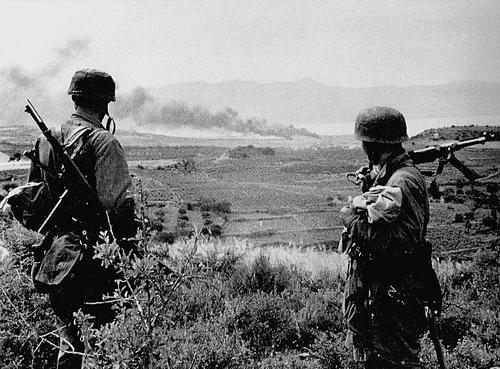
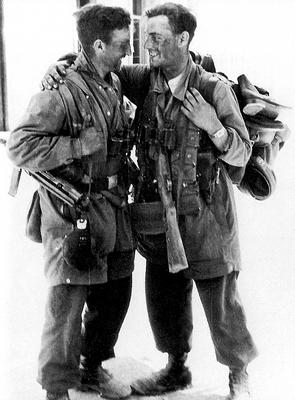
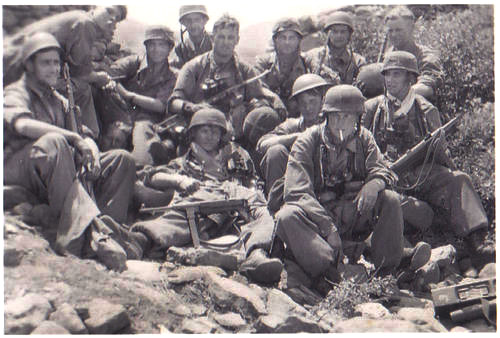
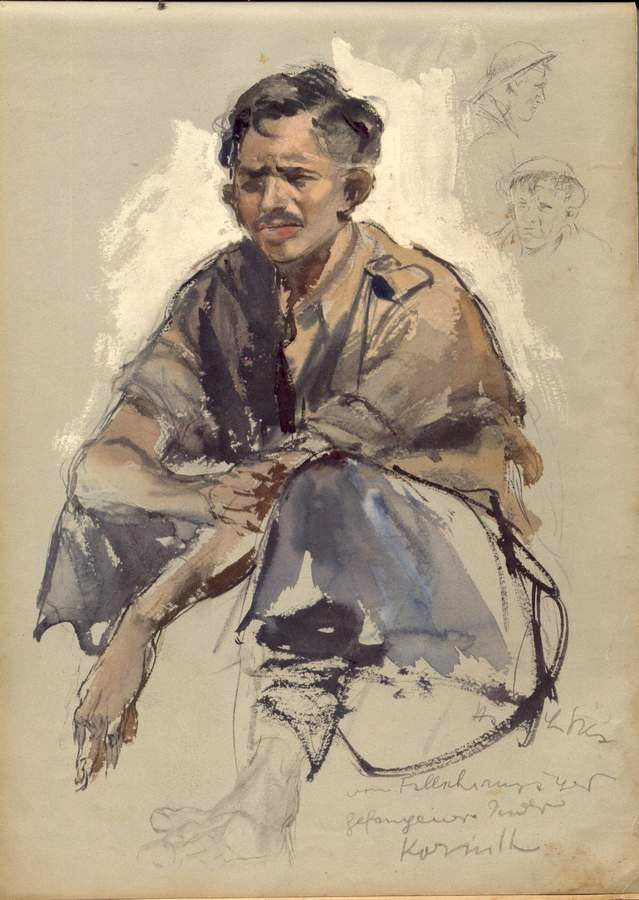
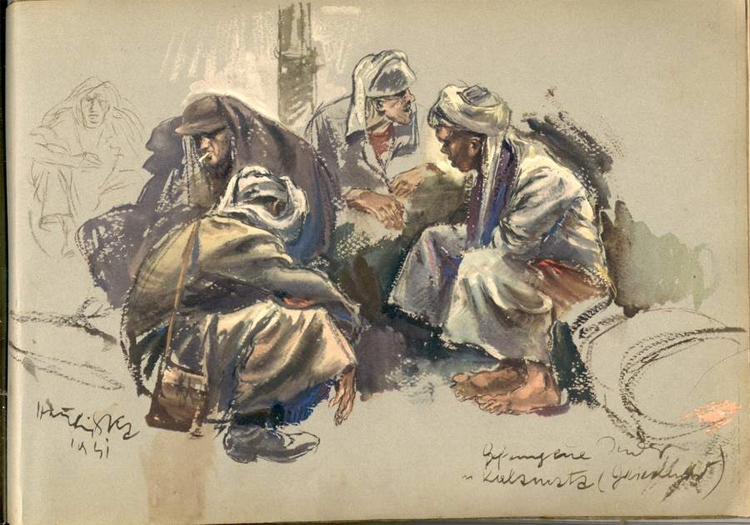
Ran, absolutely fantastic! One item I picked up on was your mods to the forearms. I like how you left the articulation in but made for a realistic forearm, well done, a great technique. Once again an excellent figure and a treat to read the history. It really does add to my understanding and appreciation of your portrayal. You captured the look and the feel, thanks…..Jim
Thanks Jim, glad you liked it!!!
Hi Ran,
I love it, but I particularly love the arms. Are they Tony Barton resin arms, or did you make them? If you did make them, would you care to share how?
Thanks buddy,
Vic
Pingback: Why Germany Was Forced Into Invading Greece, Crete, North Africa & Yugoslavia: It Was Not For Territorial Expansion – WEARS WAR on the Lies, Liars & WW2